英语八种基本句型
- 格式:pptx
- 大小:883.67 KB
- 文档页数:14

高中英语必备基础句型和8大时态结构必背句型句型1:There+be +主语+地点状语/ 时间状语There're three books on the table.桌子上有三本书。
句型2:What's wrong with+sb./sth.?What's wrong with your telephone?你的手机有什么毛病?句型3:How do you like…?How do you like China?你觉得中国怎么样?句型4:What do you like about…?What do you like about China?你喜欢中国的什么?句型5:had better(not)+动词原形You'd better ask that policeman over there. 你最好去问问那边的那个警察。
句型7:Thank+sb.+for (doing) sth. Thank you for coming to see me.感谢你来看我。
句型8:So+be/情态动词/助动词+主语He is a student. So am I.他是一个学生,我也是。
句型9:not…until…He didn't have supper until his parents came back.直到他的父母回来他才吃饭。
句型10:比较级十and+比较级The baby cried harder and harder.那孩子哭得越来越厉害。
句型11:the+比较级,the+比较级The more one has,the more one wants.拥有的越多,想要的越多。
句型12:…as+adj./adv.+as……not as(so)+adj./adv.+as…Last Sunday the weather was not so wet as it is today. 上个星期天的天气不如今天的天气潮湿。
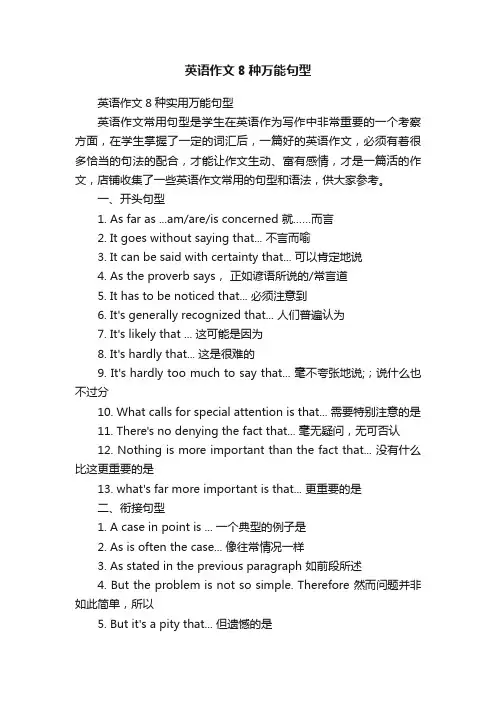
英语作文8种万能句型英语作文8种实用万能句型英语作文常用句型是学生在英语作为写作中非常重要的一个考察方面,在学生掌握了一定的词汇后,一篇好的英语作文,必须有着很多恰当的句法的配合,才能让作文生动、富有感情,才是一篇活的作文,店铺收集了一些英语作文常用的句型和语法,供大家参考。
一、开头句型1. As far as ...am/are/is concerned 就……而言2. It goes without saying that... 不言而喻3. It can be said with certainty that... 可以肯定地说4. As the proverb says,正如谚语所说的/常言道5. It has to be noticed that... 必须注意到6. It's generally recognized that... 人们普遍认为7. It's likely that ... 这可能是因为8. It's hardly that... 这是很难的9. It's hardly too much to say that... 毫不夸张地说;;说什么也不过分10. What calls for special attention is that... 需要特别注意的是11. There's no denying the fact that... 毫无疑问,无可否认12. Nothing is more important than the fact that... 没有什么比这更重要的是13. what's far more important is that... 更重要的是二、衔接句型1. A case in point is ... 一个典型的例子是2. As is often the case... 像往常情况一样3. As stated in the previous paragraph 如前段所述4. But the problem is not so simple. Therefore 然而问题并非如此简单,所以5. But it's a pity that... 但遗憾的是6. For all that...对于这一切7. In spite of the fact that... 尽管事实是8. Further, we hold opinion that... 此外,我们坚持认为9. However , the difficulty lies in... 然而,困难在于10. Similarly, we should pay attention to... 类似地,我们要注意11. not(that)...but(that)... 不是,而是12. In view of the present station 鉴于目前形势13. As has been mentioned above... 正如上面所提到的14. In this respect, we may as well (say) 从这个角度上我们可以说15. However, we have to look at the other side of the coin, that is... 然而我们还得看到事物的另一方面,即三、结尾句型1. I will conclude by saying... 最后我要说2. Therefore, we have the reason to believe that... 因此,我们有理由相信3. All things considered 总而言之4. It may be safely said that... 可以有把握地说5. Therefore, in my opinion, it's more advisable... 因此,在我看来,更可取的是6. From what has been discussed above, we may safely draw the conclusion that…. 通过以上讨论,我们可以得出结论7. The data/statistics/figures lead us to the conclusion that…. 通过数据我们得到的结论是8. It can be concluded from the discussion that... 从中我们可以得出这样的结论9. From my point of view, it would be better if... 在我看来,如果…也许会更好四、举例句型1. Let's take...to illustrate this. 让我们用……来说明这一点(let's take the above chart as an example to illustrate this. 让我们以上面的图表为例来说明这一点。
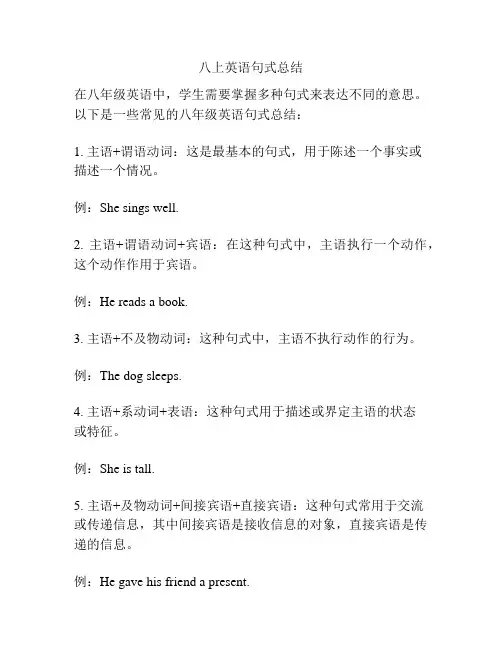
八上英语句式总结在八年级英语中,学生需要掌握多种句式来表达不同的意思。
以下是一些常见的八年级英语句式总结:1. 主语+谓语动词:这是最基本的句式,用于陈述一个事实或描述一个情况。
例:She sings well.2. 主语+谓语动词+宾语:在这种句式中,主语执行一个动作,这个动作作用于宾语。
例:He reads a book.3. 主语+不及物动词:这种句式中,主语不执行动作的行为。
例:The dog sleeps.4. 主语+系动词+表语:这种句式用于描述或界定主语的状态或特征。
例:She is tall.5. 主语+及物动词+间接宾语+直接宾语:这种句式常用于交流或传递信息,其中间接宾语是接收信息的对象,直接宾语是传递的信息。
例:He gave his friend a present.6. There be句型:这种句式用于描述某物或某些事物的存在。
例:There is a cat on the table.7. It 句型:这种句式中,"it"作为形式主语或形式宾语。
例:It is raining outside.8. 定语从句:这种句式用于添加附加信息来进一步描述名词。
例:The book that she is reading is interesting.9. 状语从句:这种句式用于描述时间、地点、原因、条件等。
例:He will go to the party if he finishes his homework.10. 宾语从句:这种句式用于作为宾语的从句,通常用于表达一种观点或想法。
例:She believes that honesty is important.这些是一些常见的八年级英语句式,掌握这些句式可以帮助学生更准确地表达自己的意思。
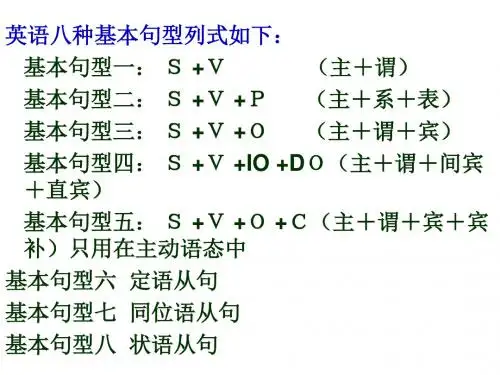
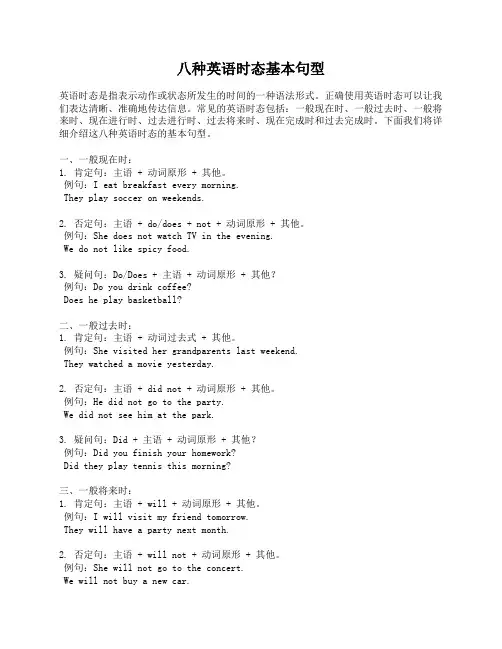
八种英语时态基本句型英语时态是指表示动作或状态所发生的时间的一种语法形式。
正确使用英语时态可以让我们表达清晰、准确地传达信息。
常见的英语时态包括:一般现在时、一般过去时、一般将来时、现在进行时、过去进行时、过去将来时、现在完成时和过去完成时。
下面我们将详细介绍这八种英语时态的基本句型。
一、一般现在时:1. 肯定句:主语 + 动词原形 + 其他。
例句:I eat breakfast every morning.They play soccer on weekends.2. 否定句:主语 + do/does + not + 动词原形 + 其他。
例句:She does not watch TV in the evening.We do not like spicy food.3. 疑问句:Do/Does + 主语 + 动词原形 + 其他?例句:Do you drink coffee?Does he play basketball?二、一般过去时:1. 肯定句:主语 + 动词过去式 + 其他。
例句:She visited her grandparents last weekend.They watched a movie yesterday.2. 否定句:主语 + did not + 动词原形 + 其他。
例句:He did not go to the party.We did not see him at the park.3. 疑问句:Did + 主语 + 动词原形 + 其他?例句:Did you finish your homework?Did they play tennis this morning?三、一般将来时:1. 肯定句:主语 + will + 动词原形 + 其他。
例句:I will visit my friend tomorrow.They will have a party next month.2. 否定句:主语 + will not + 动词原形 + 其他。
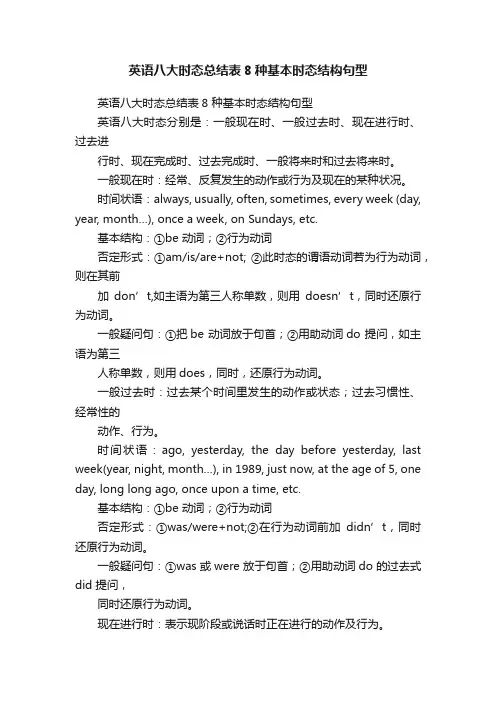
英语八大时态总结表8种基本时态结构句型英语八大时态总结表8 种基本时态结构句型英语八大时态分别是:一般现在时、一般过去时、现在进行时、过去进行时、现在完成时、过去完成时、一般将来时和过去将来时。
一般现在时:经常、反复发生的动作或行为及现在的某种状况。
时间状语:always, usually, often, sometimes, every week (day, year, month…), once a week, on Sundays, etc.基本结构:①be 动词;②行为动词否定形式:①am/is/are+not; ②此时态的谓语动词若为行为动词,则在其前加don’t,如主语为第三人称单数,则用doesn’t,同时还原行为动词。
一般疑问句:①把be 动词放于句首;②用助动词do 提问,如主语为第三人称单数,则用does,同时,还原行为动词。
一般过去时:过去某个时间里发生的动作或状态;过去习惯性、经常性的动作、行为。
时间状语:ago, yesterday, the day before yesterday, last week(year, night, month…), in 1989, just now, at the age of 5, one day, long long ago, once upon a time, etc.基本结构:①be 动词;②行为动词否定形式:①was/were+not;②在行为动词前加didn’t,同时还原行为动词。
一般疑问句:①was 或were 放于句首;②用助动词do 的过去式did 提问,同时还原行为动词。
现在进行时:表示现阶段或说话时正在进行的动作及行为。
时间状语:now, at this time, these days, etc.。

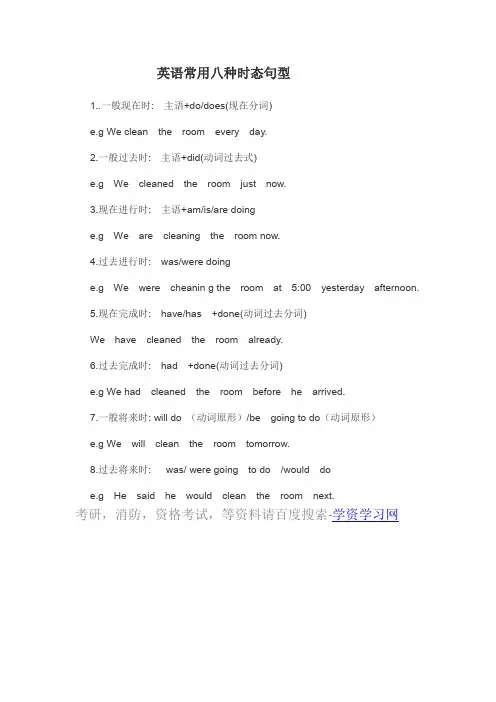
英语常用八种时态句型
1..一般现在时: 主语+do/does(现在分词)
e.g We clean the room every day.
2.一般过去时: 主语+did(动词过去式)
e.g We cleaned the room just now.
3.现在进行时: 主语+am/is/are doing
e.g We are cleaning the room now.
4.过去进行时: was/were doing
e.g We were cheanin g the room at 5:00 yesterday afternoon.
5.现在完成时: have/has +done(动词过去分词)
We have cleaned the room already.
6.过去完成时: had +done(动词过去分词)
e.g We had cleaned the room before he arrived.
7.一般将来时: will do (动词原形)/be going to do(动词原形)
e.g We will clean the room tomorrow.
8.过去将来时: was/ were going to do /would do
e.g He said he would clean the room next.
考研,消防,资格考试,等资料请百度搜索-学资学习网。
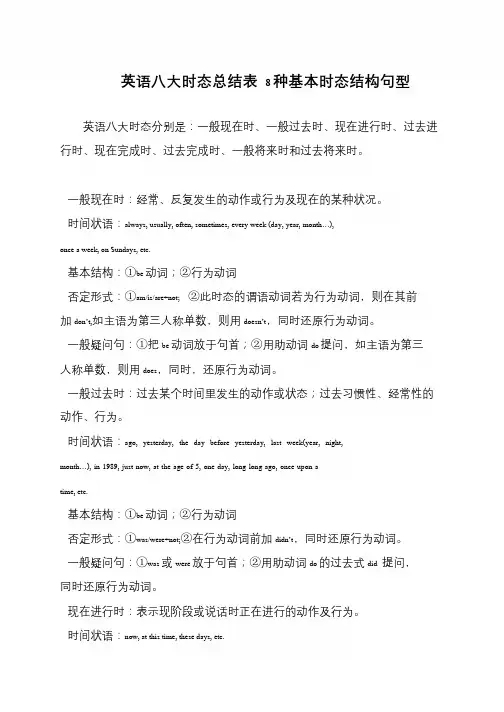
英语八大时态总结表8 种基本时态结构句型英语八大时态分别是:一般现在时、一般过去时、现在进行时、过去进行时、现在完成时、过去完成时、一般将来时和过去将来时。
一般现在时:经常、反复发生的动作或行为及现在的某种状况。
时间状语:always, usually, often, sometimes, every week (day, year, month…),once a week, on Sundays, etc.基本结构:①be 动词;②行为动词否定形式:①am/is/are+not; ②此时态的谓语动词若为行为动词,则在其前加don’t,如主语为第三人称单数,则用doesn’t,同时还原行为动词。
一般疑问句:①把be 动词放于句首;②用助动词do 提问,如主语为第三人称单数,则用does,同时,还原行为动词。
一般过去时:过去某个时间里发生的动作或状态;过去习惯性、经常性的动作、行为。
时间状语:ago, yesterday, the day before yesterday, last week(year, night,month…), in 1989, just now, at the age of 5, one day, long long ago, once upon atime, etc.基本结构:①be 动词;②行为动词否定形式:①was/were+not;②在行为动词前加didn’t,同时还原行为动词。
一般疑问句:①was 或were 放于句首;②用助动词do 的过去式did 提问,同时还原行为动词。
现在进行时:表示现阶段或说话时正在进行的动作及行为。
时间状语:now, at this time, these days, etc.。
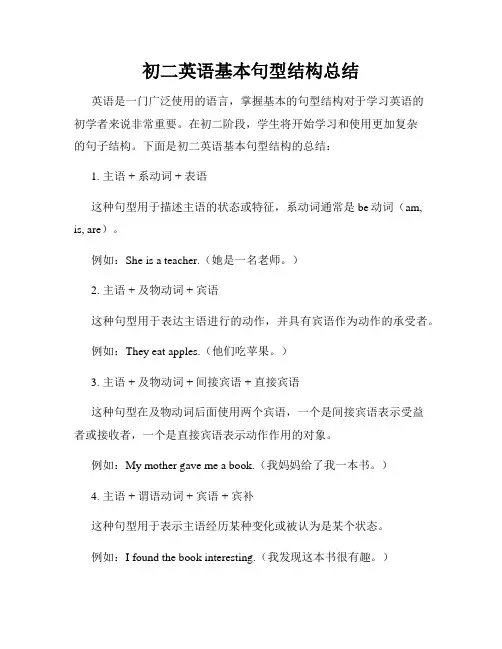
初二英语基本句型结构总结英语是一门广泛使用的语言,掌握基本的句型结构对于学习英语的初学者来说非常重要。
在初二阶段,学生将开始学习和使用更加复杂的句子结构。
下面是初二英语基本句型结构的总结:1. 主语 + 系动词 + 表语这种句型用于描述主语的状态或特征,系动词通常是be动词(am, is, are)。
例如:She is a teacher.(她是一名老师。
)2. 主语 + 及物动词 + 宾语这种句型用于表达主语进行的动作,并具有宾语作为动作的承受者。
例如:They eat apples.(他们吃苹果。
)3. 主语 + 及物动词 + 间接宾语 + 直接宾语这种句型在及物动词后面使用两个宾语,一个是间接宾语表示受益者或接收者,一个是直接宾语表示动作作用的对象。
例如:My mother gave me a book.(我妈妈给了我一本书。
)4. 主语 + 谓语动词 + 宾语 + 宾补这种句型用于表示主语经历某种变化或被认为是某个状态。
例如:I found the book interesting.(我发现这本书很有趣。
)5. 主语 + 及物动词 + 宾语 + 宾语补足语这种句型加强了对宾语的描述,通常使用形容词或名词作为补足语。
例如:We painted the wall white.(我们把墙刷成了白色。
)6. 主语 + 动词 + 副词这种句型用于描述主语进行某种动作的方式或程度。
例如:He sings beautifully.(他唱得很好听。
)7. 主语 + 情态动词 + 动词原形情态动词用来表示说话人的意愿、命令、建议或推测等情态。
例如:You should study hard.(你应该努力学习。
)8. There be句型这种句型用于表达某个地方、时间或存在某种情况下存在某物或某人。
例如:There is a dog in the garden.(花园里有一只狗。
)9. 疑问句句型疑问句句型用于提问,在句子前加上疑问词来引导问题。

英语八大时态总结表 8种基本时态结构句型英语八大时态总结表8种基本时态结构句型英语八大时态分别是:一般现在时、一般过去时、现在进行时、过去进行时、现在完成时、过去完成时、一般将来时和过去将来时。
通常现在时:经常、反反复复出现的动作或犯罪行为及现在的某种状况。
时间状语:always,usually,often,sometimes,everyweek(day,year,month…),onceaweek,onsundays,etc.基本结构:①be动词;②犯罪行为动词否定形式:①am/is/are+not;②此时态的谓语动词若为行为动词,则在其前加don't,如主语为第三人称单数,则用doesn't,同时还原行为动词。
通常疑问句:①把be动词摆于句首;②用助动词do回答,例如主语为第三人称单数,则用does,同时,还原成犯罪行为动词。
一般过去时:过去某个时间里发生的动作或状态;过去习惯性、经常性的动作、行为。
时间状语:ago,yesterday,thedaybeforeyesterday,lastweek(year,night,month…),in1989,justno w,attheageof5,oneday,longlongago,onceuponatime,etc.基本结构:①be动词;②行为动词驳斥形式:①was/were+not;②在犯罪行为动词kadidn't,同时还原成犯罪行为动词。
一般疑问句:①was或were放于句首;②用助动词do的过去式did提问,同时还原行为动词。
现在展开时:则表示现阶段或骂人时正在展开的动作及犯罪行为。
时间状语:now,atthistime,thesedays,etc.基本结构:am/is/are+doing否定形式:am/is/are+not+doing.通常疑问句:把be动词摆于句首。
过去进行时:表示过去某段时间或某一时刻正在发生或进行的行为或动作。
八大句型结构英语例句1. S + V + O (Subject + Verb + Object)1. He bought a new car.2. They love playing soccer.3. She read a book last night.4. We visited the museum yesterday.5. The dog chased the cat.6. The students listened to the teacher.7. I ate a delicious pizza for dinner.8. She painted a beautiful picture.2. S + V + O + O (Subject + Verb + Object + Object)9. I gave him a gift.10. She showed me her new phone.11. He offered her a chair.12. They taught us English.13. We told them the truth.14. The doctor prescribed him some medication.15. The waiter served us delicious food.16. My mom baked me a cake.3. S + V + O + C (Subject + Verb + Object + Complement)17. He painted his room blue.18. She cut her hair short.19. We found the answer correct.20. They named their baby girl Sophia.21. I consider her a good friend.22. The teacher declared the project complete.23. My parents deemed the movie excellent.24. The doctor pronounced the patient healthy.4. S + Linking Verb + Predicate Adjective (Subject + Linking Verb + Predicate Adjective)25. She is beautiful.26. He is tired.27. They are happy.28. The cake tasted delicious.29. The flowers smell wonderful.30. The book seems interesting.31. The movie appears captivating.32. The weather remains sunny.5. S + Linking Verb + Predicate Noun (Subject + Linking Verb + Predicate Noun)33. She is a doctor.34. He became an engineer.35. They are students.36. I am a teacher.37. We were friends.38. The cat became a mother.39. The tree turned into a birdhouse.40. The puppy grew into a big dog.6. S + V + Adv. (Subject + Verb + Adverb)41. He runs quickly.42. She speaks fluently.43. They studied hard.44. I read slowly.45. We danced gracefully.46. The car drives smoothly.47. The dog barks loudly.48. The child cried softly.7. S + V + Prep. Phrase (Subject + Verb + Prepositional Phrase)49. She walked to the park.50. He ran against the wind.51. They sat by the river.52. I swam in the pool.53. We lived in a small town.54. The cat jumped onto the table.55. The book fell from the shelf.56. The bird flew over the mountains.。
英语六种基本句型一、六种基本句型1. 主语+不及物动词例: I do.2. 主语+不及物动词+状语例:He left last night.3. 主语+动词(及物动词)+宾语例:I have a son.4. 主语+谓语(及物动词)+双宾语(间接宾语+直接宾语)例:I can give you an apple.指人的是间接宾语和指物的是直接宾语5. 主语+谓语(系动词)+表语该句型谓语动词为连系动词.常见的系动词有:be(是); get(变得), become(成为), turn(变得), look(看起来), feel(感到), smell(闻起来), taste(尝起来), sound(听起来), seem(似乎) 等.例:The apple tastes good.6. 主语+谓语+宾语+宾语补足语6.1. 接形容词作宾语补足语例1:You make me happy.例2:You keep me waiting.6.2. 接动词不定式作宾语补足语例:Our teacher told Tom to come here tomorrow.6.3. 宾语补足语为动词原形或doing形式四看:watch、see、look、notice、observe二听:listen to (听)、hear(听见)一感觉:feel(感觉)宾语补足语用动词原形 (省略to)表示全过程,用doing形式表示该动作当时正在发生。
例1: We see her dance in the next door.我们看到她在隔壁跳舞。
(全过程)例2: We see her dancing in the next door. 我们看到她正在在隔壁跳舞.。
英语中几种基本的句子结构一、句型1:Subject (主语) +Verb (谓语)这种句型中的动词大多是不及物动词,所谓不及物动词,就是这种动词后不可以直接接宾语。
常见的动词如:work, sing, swim, fish, jump, arrive, come, die, disappear, cry, happen等。
如:1) Li Ming works very hard.李明学习很努力。
2) The accident happened yesterday afternoon.事故是昨天下午发生的。
3)Spring is coming.4) We have lived in the city for ten years.二、句型2:Subject (主语) +Link. V(系动词) +Predicate(表语)这种句型主要用来表示主语的特点、身份等。
其系动词一般可分为下列两类:(1)表示状态。
这样的词有:be, look, seem, smell, taste, sound, keep等。
如:1) This kind of food tastes delicious.这种食物吃起来很可口。
2) He looked worried just now.刚才他看上去有些焦急。
(2)表示变化。
这类系动词有:become, turn, get, grow, go等。
如:1) Spring comes. It is getting warmer and warmer.春天到了,天气变得越来越暖和。
2) The tree has grown much taller than before.这棵树比以前长得高多了。
三、句型3:Subject(主语) +Verb (谓语) +Object (宾语)这种句型中的动词一般为及物动词, 所谓及物动词,就是这种动词后可以直接接宾语,其宾语通常由名词、代词、动词不定式、动名词或从句等来充当。
初中英语语法及八种基本句型写出下列各句的基本句式结构1.(教材P2)My name is Amy.主语+系动词+表语2.(教材P3)A boy meets a girl during a break.主语+谓语+宾语+状语3.(教材P6)We must act.主语+谓语4.(教材P6)The teacher found the classroom empty.主语+谓语+宾语+宾补5.(教材P6)My mum bought me a new dictionary.主语+谓语+间接宾语+直接宾语句子成分句子表达一个完整的意思,是由单词按一定的语法规则组合而成的。
句子一般可以分成几个部分,每个部分在句中具有一定的功能,称为句子成分。
不同的句子成分由一定的词类或词组充当。
1.主语(subject)主语是一句话的主体,表明句子说的是谁或是什么。
它一般放在谓语之前,通常由名词(名词短语)、代词、数词、动词不定式、动名词以及名词性从句等担任。
◆TV news often gives us lots of information.电视新闻常常给我们许多信息。
(名词)◆Something is wrong with my computer.我的电脑坏了。
(代词)◆Seven-tenths of the earth surface is covered with water.十分之七的地球表面被水覆盖。
(数词)◆To see is to believe.眼见为实。
(动词不定式)◆Cycling and boating are my favorite free time interests.骑车和划船是我业余最大的兴趣爱好。
(动名词)◆That she was admitted into a key university greatly comforted her parents.她被重点大学录取这件事给了她父母极大的安慰。
人教版七年级上册初中英语句子成分和基本句型句子成分和基本句型英语的基本成分有八种:主语、谓语、表语、宾语、定语、状语、补语、同位语。
1.主语:是句子的主体,动作,行为的发出者,一般位于句首。
如:We are students.One of my classmates is from Shanghai.Eating too much is bad for your health主语位于谓语动词之前2.谓语:说明主语的动作,由动词承担He works in a factory.I can speak English.They are working in a field.He will come here tomorrow morning.谓语部分的划分要把时态、被动语态、情态动词和否定词归入进去。
3.宾语:动作的承受者。
如:He is doing his homework.They did nothing this morning.We enjoy playing football.4.表语:它的位置在系动词后面。
1. be动词系动词 2. 感官动词feel, see, look, sound, hear, taste...渐变动词get, turn, become,保持状态的词keep,remain,continue,stayYou look young.My father is a teacher.I feel terrible.5.定语;用来修饰限定名词或代词。
如:The black bike is mine.They made some paper flowers.The tall boy who is standing there is Peter.What about something to drink前置定语------后置定语6.状语:表示时间、地点、目的、方式、程度等,He will visit his mother on Saturday.I read books in the library.I go to school by bus.同位语:即“同等位置”,一个名词来解释说明另一个词。